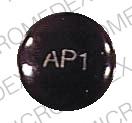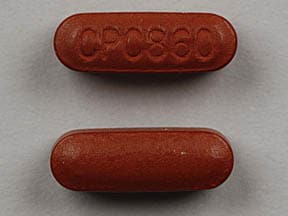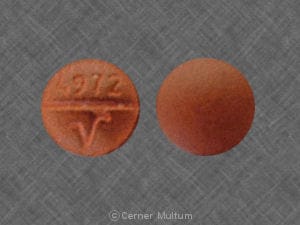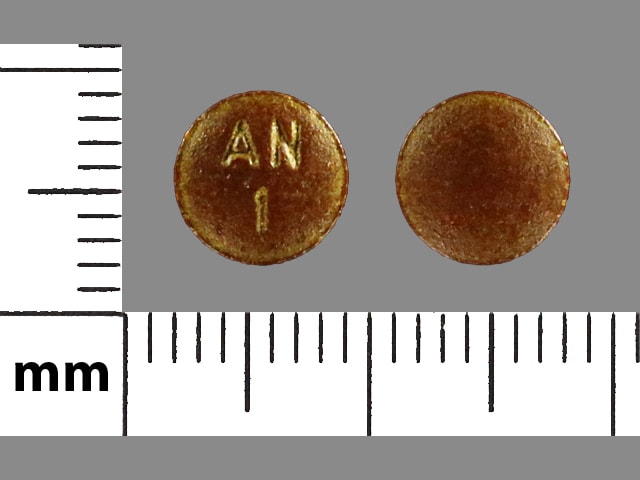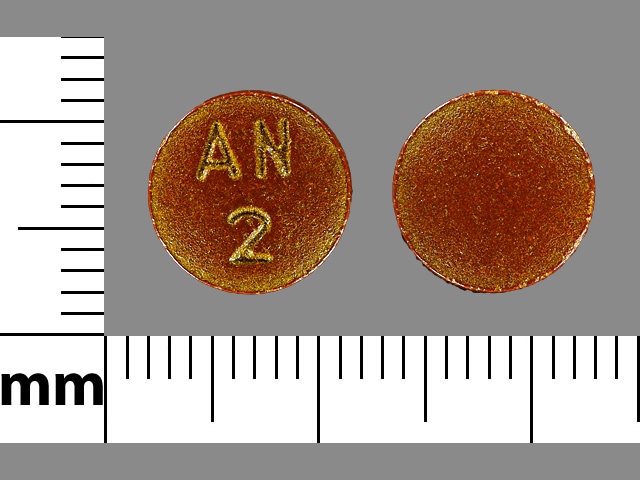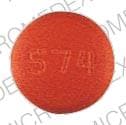Dosage Forms
Excipient information presented when available (limited, particularly for generics); consult specific product labeling. [DSC] = Discontinued product
Tablet, Oral:
AZO Urinary Pain Relief: 99.5 mg [contains corn starch]
Tablet, Oral, as hydrochloride:
Baridium: 97.2 mg [DSC]
Pyridium: 100 mg, 200 mg
Urinary Pain Relief: 95 mg
Generic: 100 mg, 200 mg
Pharmacology
Mechanism of Action
An azo dye which exerts local anesthetic or analgesic action on urinary tract mucosa through an unknown mechanism
Pharmacokinetics/Pharmacodynamics
Metabolism
In the liver and other tissues
Excretion
Urine (66% as unchanged drug)
Use: Labeled Indications
Dysuria, symptomatic relief: Symptomatic relief of pain, burning, urgency, frequency, and other discomforts arising from irritation of the lower urinary tract mucosa caused by infection, trauma, surgery, endoscopic procedures, or the passage of sounds or catheters.
Contraindications
Hypersensitivity to phenazopyridine or any component of the formulation; renal insufficiency.
Dosage and Administration
Dosing: Adult
Dysuria, symptomatic relief: Oral:
OTC labeling: Two tablets (190 mg) 3 times daily administered with or after meals for up to 2 days.
Rx labeling: 200 mg 3 times daily after meals for 2 days when used concomitantly with an antibacterial agent.
Dosing: Geriatric
Refer to adult dosing.
Dosing: Pediatric
Dysuria, urinary tract pain; symptomatic relief: Note: Generally, the use of phenazopyridine is not included by experts as a therapeutic consideration for pediatric UTI management (AAP 2011; Kliegman 2016; Red Book [AAP 2015])
Children <12 years: Limited data available: Oral: 12 mg/kg/day in 3 divided doses; maximum dose: 200 mg/dose (Gearhart 2010; Kliegman 2007, Rudolph 1996); some experts suggest a minimum age of 6 years (Gearhart 2010). Limit therapy to 2 days if being used for UTI.
Children ≥12 years and Adolescents: Oral: OTC 95 mg/tablet formulation: 190 mg (2 tablets) 3 times daily as needed; limit therapy to 2 days if being used for UTI
Administration
Administer after meals.
Dietary Considerations
Take after meals.
Storage
Store at 20°C to 25°C (68°F to 77°F); excursions are permitted between 15°C and 30°C (59°F and 86°F). Protect from light and moisture.
Phenazopyridine Images
Drug Interactions
Dapsone (Topical): May enhance the adverse/toxic effect of Methemoglobinemia Associated Agents. Monitor therapy
Local Anesthetics: Methemoglobinemia Associated Agents may enhance the adverse/toxic effect of Local Anesthetics. Specifically, the risk for methemoglobinemia may be increased. Monitor therapy
Nitric Oxide: May enhance the adverse/toxic effect of Methemoglobinemia Associated Agents. Combinations of these agents may increase the likelihood of significant methemoglobinemia. Monitor therapy
Prilocaine: Methemoglobinemia Associated Agents may enhance the adverse/toxic effect of Prilocaine. Combinations of these agents may increase the likelihood of significant methemoglobinemia. Management: Monitor patients for signs of methemoglobinemia (e.g., hypoxia, cyanosis) when prilocaine is used in combination with other agents associated with development of methemoglobinemia. Avoid lidocaine/prilocaine in infants receiving such agents. Monitor therapy
Sodium Nitrite: Methemoglobinemia Associated Agents may enhance the adverse/toxic effect of Sodium Nitrite. Combinations of these agents may increase the likelihood of significant methemoglobinemia. Monitor therapy
Test Interactions
Phenazopyridine may interfere with glucose oxidase reagents (Clinistix, Tes-Tape) and urine ketone tests (Acetest, Ketostix).
Adverse Reactions
1% to 10%:
Central nervous system: Headache, dizziness
Gastrointestinal: Stomach cramps
<1%, postmarketing, and/or case reports: Acute renal failure, hemolytic anemia, hepatitis, methemoglobinemia, skin pigmentation, skin rash, vertigo
Warnings/Precautions
Concerns related to adverse effects:
- Acute renal failure: Acute renal failure has been reported with larger than recommended doses, primarily in patients with preexisting renal disease, although some reports have occurred in patients without preexisting renal disease (Alano 1970; Holmes 2014; Onder 2006). Acute renal failure secondary to phenazopyridine toxicity is usually accompanied by hemolytic anemia, yellow discoloration of the skin, and methemoglobinemia, although acute renal failure can occur in isolation (Holmes 2014). Acute renal failure has also been reported following use of usual recommended doses in patients without preexisting renal impairment (Shahani 2012; Singh 2014).
- Urine discoloration: A reddish-orange discoloration of the urine occurs.
- Yellow discoloration: Drug should be discontinued if skin or sclera develop a yellow color (may indicate drug accumulation due to impaired renal excretion).
Disease-related concerns:
- Renal impairment: Use is contraindicated in patients with renal impairment (although a specific degree of impairment is not defined in the manufacturer's labeling). Use in patients with preexisting chronic kidney disease has been associated with acute renal failure, hemolytic anemia, and methemoglobinemia (Chang 2014).
Special populations:
- Elderly: Use with caution in older adults due to potential for accumulation in patients with renal insufficiency.
- G6PD deficiency: Use caution in patients with G6PD deficiency; hemolytic anemia may occur in the setting of chronic overdose. OTC labeling recommends use only when directed by physician.
Other warnings/precautions:
- Contact lenses: Staining of contact lenses may occur if handled after touching tablets.
- Limitations of use: Does not treat urinary infection, acts only as an analgesic.
- Self-medication (OTC use): When used for self-medication, patients should be instructed to discontinue use if symptoms last for more than 2 days or if an adverse reaction occurs.
- Staining: May stain fabric or clothing.
Pregnancy
Pregnancy Risk Factor
B
Pregnancy Considerations
Adverse events have not been observed in animal reproduction studies. Phenazopyridine crosses the placenta and can be detected in amniotic fluid (Meyer 1991).
Patient Education
What is this drug used for?
- It is used to ease pain from a bladder infection.
- It is used to treat urinary signs.
Frequently reported side effects of this drug
- Headache
- Nausea
- Vomiting
- Diarrhea
Other side effects of this drug: Talk with your doctor right away if you have any of these signs of:
- Methemoglobinemia like blue or gray color of the lips, nails, or skin; arrhythmia; seizures; severe dizziness or passing out; severe headache; fatigue; loss of strength and energy; or shortness of breath.
- Liver problems like dark urine, feeling tired, lack of appetite, nausea, abdominal pain, light-colored stools, vomiting, or yellow skin or eyes.
- Severe loss of strength and energy
- Unable to pass urine
- Change in amount of urine passed
- Vision changes
- Signs of a significant reaction like wheezing; chest tightness; fever; itching; bad cough; blue skin color; seizures; or swelling of face, lips, tongue, or throat.
Note: This is not a comprehensive list of all side effects. Talk to your doctor if you have questions.
Consumer Information Use and Disclaimer: This information should not be used to decide whether or not to take this medicine or any other medicine. Only the healthcare provider has the knowledge and training to decide which medicines are right for a specific patient. This information does not endorse any medicine as safe, effective, or approved for treating any patient or health condition. This is only a brief summary of general information about this medicine. It does NOT include all information about the possible uses, directions, warnings, precautions, interactions, adverse effects, or risks that may apply to this medicine. This information is not specific medical advice and does not replace information you receive from the healthcare provider. You must talk with the healthcare provider for complete information about the risks and benefits of using this medicine.
